How To Feed A Sourdough Starter: Maintenance Guide
This post may contain affiliate links.
So you've created a bubbly sourdough starter. Now you need to know how to feed a sourdough starter once it's established. Here you'll learn how to feed, maintain and store your active sourdough starter.
Creating a sourdough starter doesn't end at day 14. You need an easy starter maintenance routine to keep your starter alive - and most importantly - thriving!
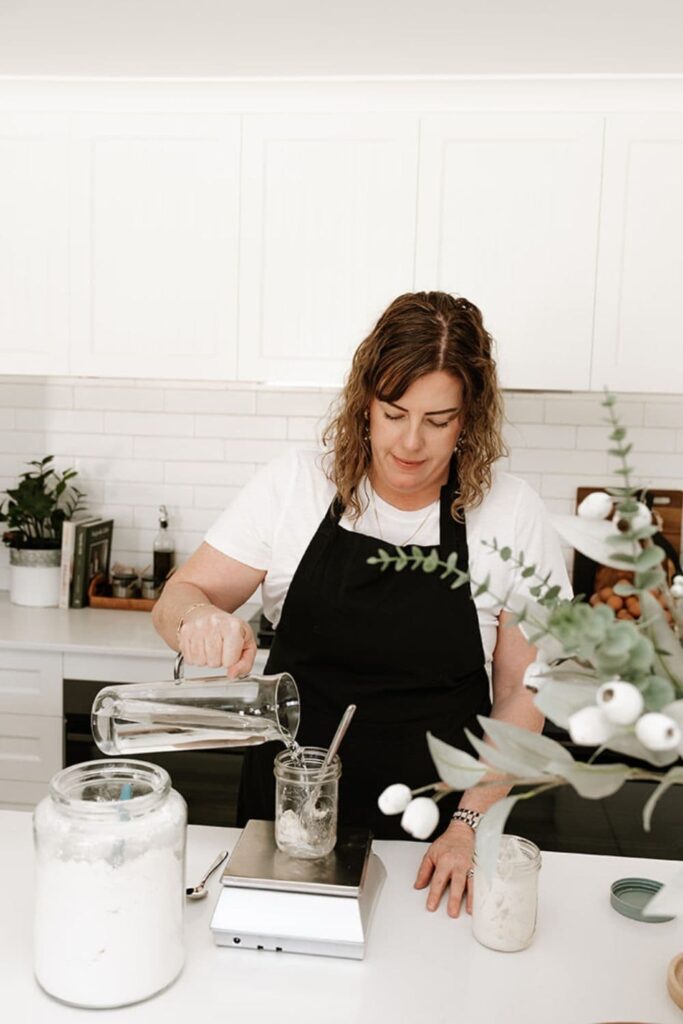
This article aims to show you how to feed a sourdough starter once it's established. It will show you how to care for sourdough starter beyond the initial first few weeks.
When you maintain your sourdough starter correctly with the right sourdough feeding ratio, your sourdough starter will live indefinitely and can be come a family heirloom.
If you have purchased a dried sourdough starter, you'll find instructions on how to activate a dried sourdough starter here.
What Is A Sourdough Starter?
A sourdough starter is a colony of living micro organisms. It's symbiotic culture of yeast and bacteria. Unlike commercial yeast, the wild yeast in a sourdough starter come from various sources and are a little unpredictable.
Because it's alive, it requires regular and consistent feeding - just like raising a baby, right? Well, I'll tell you after raising 3 babies ... a sourdough starter is a damn side easier!
So once your sourdough starter baby has reached maturity, it still requires love and care, just in a different way to a baby starter.
There are lots of different types of sourdough starters! You can find out about 10 of the most common sourdough starters here.
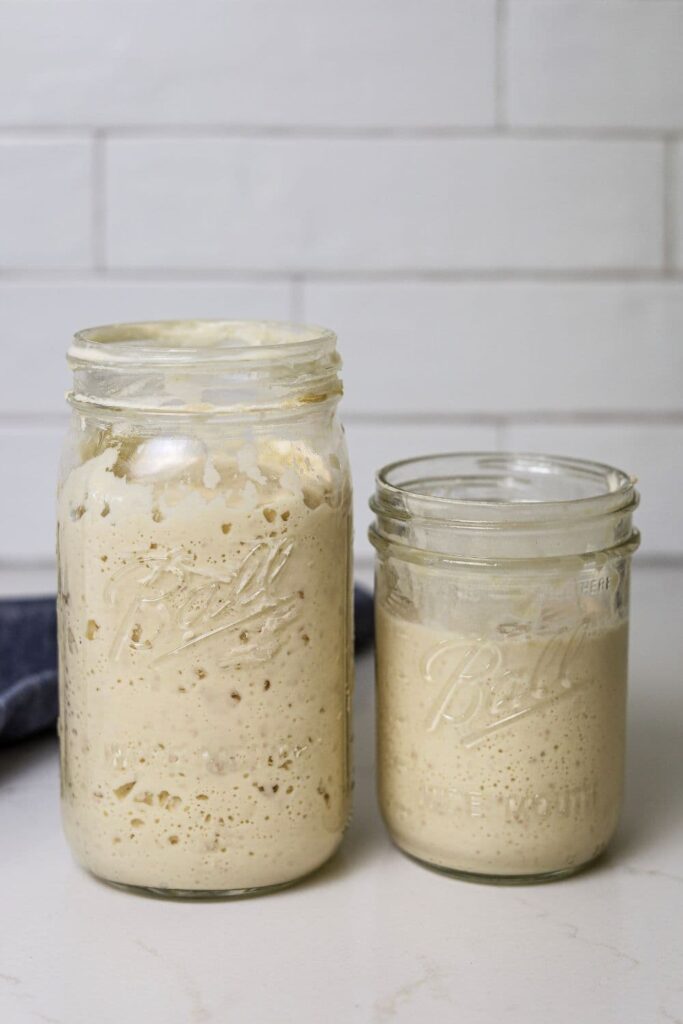
When Does Sourdough Starter Move to Maintenance Mode?
Making a sourdough starter from scratch is very different to purchasing an established starter.
When making a sourdough starter from scratch, you will need to feed your sourdough starter twice a day for several weeks and keep your sourdough starter warm. Most sourdough starters will show signs of readiness from 14 days old - but some will take up to 4 or even 6 weeks.
If your starter takes a bit longer, it doesn't mean you're doing anything wrong.
Each sourdough starter is a unique product of the wild yeast found in your flour, your environment and on your hands! This is teamed with temperature, humidity, water quality. All of these factors have a bearing on when your sourdough starter is "bake ready".
As a general rule, if you have made a sourdough starter from scratch, it's best to keep your starter on the counter and feed it twice a day for 3 to 4 months.
Once it's around 3 to 4 months old, is doubling consistently and baking good bread, you can then place it into "maintenance mode". You can find a full guide to understanding when you sourdough starter is ready to bake with here.
Of course you can still bake with your starter while you are waiting for it to mature. Most starters will be ready to use from around 14 to 30 days. While your starter won't be mature at this time, you can definitely still bake with it.
Here are 5 great beginner recipes to test out your sourdough starter with:
- Simple Sourdough Bread Recipe
- Simple Sourdough Focaccia Recipe
- Easy Sourdough Discard Sandwich Bread Recipe
- The Easiest Sourdough Discard Bread You'll Ever Make
- Easy Whole Wheat Rye Sourdough Bread
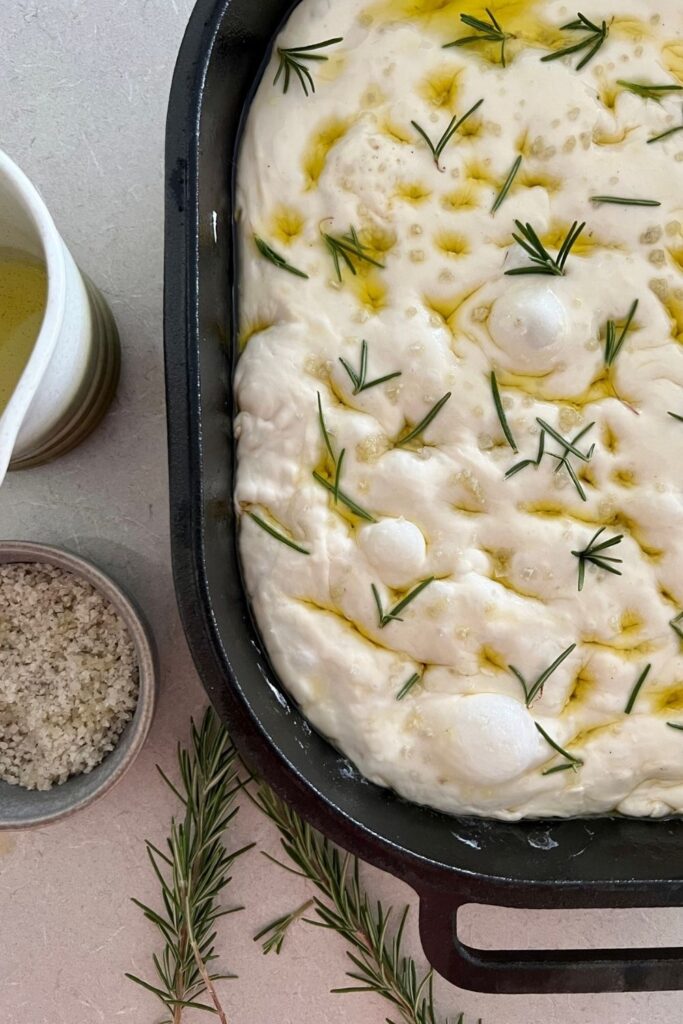
Keeping Sourdough Starter On The Counter
Once your sourdough starter has reached maturity and is ready for "maintenance" you can keep it on the counter. Many people insist that a starter needs to be put into the fridge at this stage, but there's no hard and fast rules here.
If you bake regularly (at least 3 to 4 times per week) then your starter is probably best kept on the kitchen counter.
While you've been feeding your starter twice a day up until now, at this point, you can feed your sourdough starter less.
I would first reduce the feeding to just once a day and see how your starter reacts. Generally, feeding it once a day is a good rule when leaving your starter on the counter.
Feeding it less than this can leave your starter open to mold and harmful bacteria, however you can also overfeed a sourdough starter.
If your starter seems to be ok with once a day feeding, it should be ok if you forget to feed it for a day or even if you intentionally skip a feeding - but ideally you should feed daily.
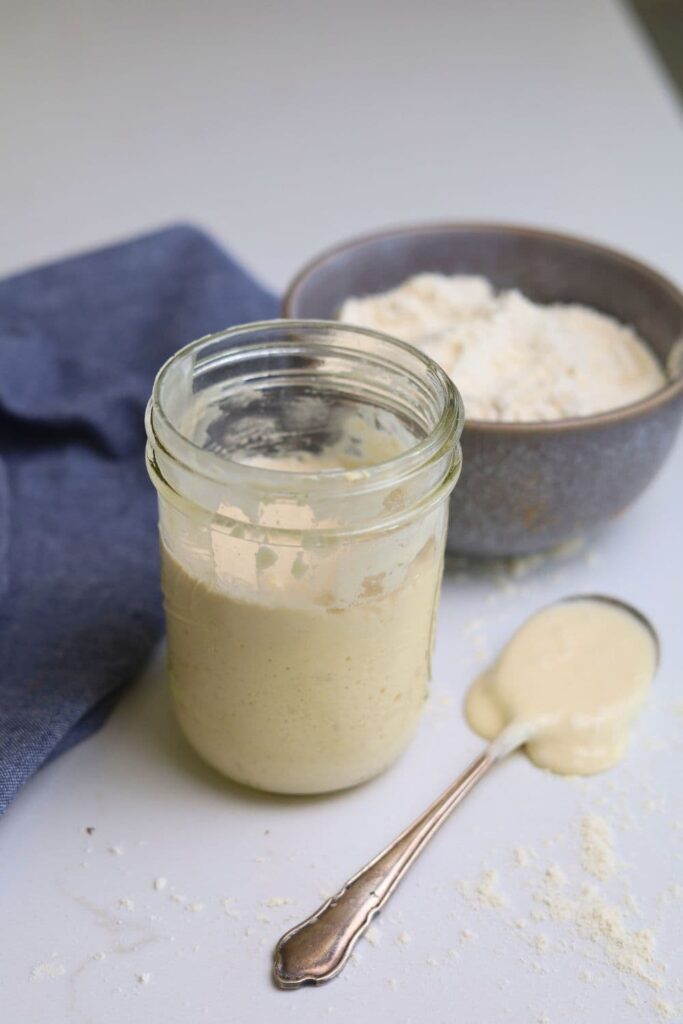
How To Feed Sourdough Starter on The Counter (Daily Feeding Method)
If you're baking every day - or at least 3 to 4 times a week, maintaining your sourdough starter on the counter makes sense.
Here's how to maintain your sourdough starter on the counter:
- Weigh out 50g of sourdough starter using a digital scale. Discard the rest of the starter (this can be used for discard recipes so long as your starter is at least 7 days old).
- To the 50g of sourdough starter, add 50g of flour and 50g of water. Stir the mixture vigorously.
- Leave the sourdough starter to rise on the counter. Use it at its peak.
- Repeat every 12 to 24 hours or as needed.
Using a rubber band can be an easy way to measure when your sourdough starter is doubling.
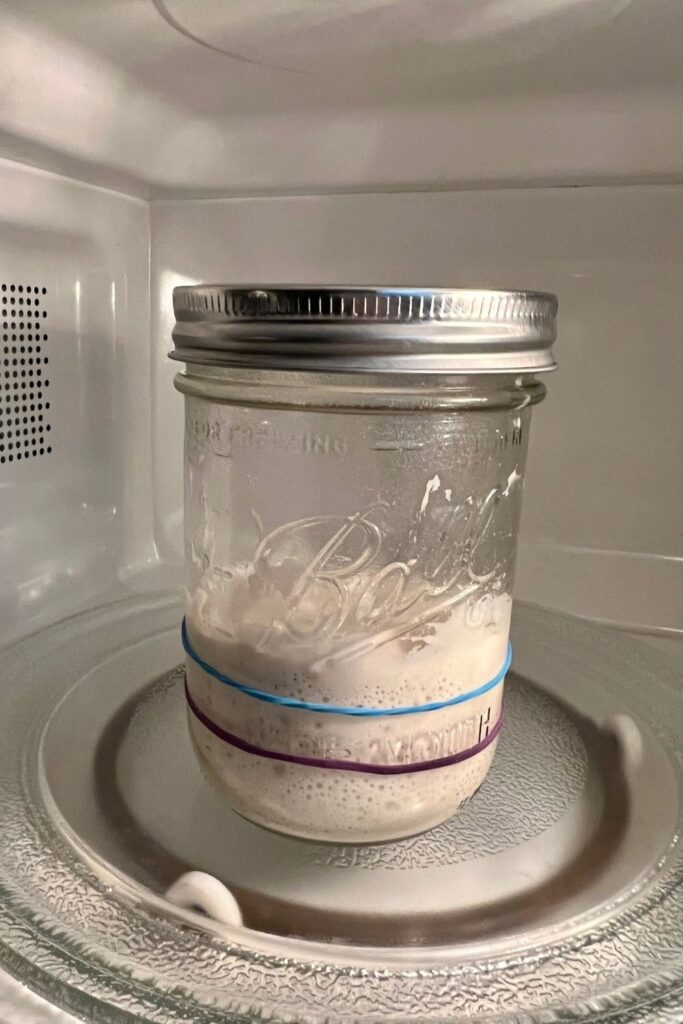
Storing Sourdough Starter In the Fridge (Weekly Feeding Method)
Once your sourdough starter is mature, you can store it in the fridge. I do not advise putting your sourdough starter in the fridge before it is 3 to 4 months old. The wild yeast colonies are not established enough prior to this point.
Putting your sourdough starter in the fridge puts it to sleep. When your starter is asleep, it is not growing or building strength. So storing it in the fridge is purely for maintenance - not growth!
Fridge storage is perfect if you don't bake daily and just want to bake once a week or once a fortnight.
Before you put your sourdough starter in the fridge, you need to feed it at a ratio of 1:2:2.
I've written a full guide on how to store your sourdough starter in the fridge here. If you want to put your sourdough starter on hold for longer, you might consider drying your sourdough starter.
Understanding Feeding Ratios
Sometimes you'll see sourdough starter expressed as a ratio. You might see 1:1:1 or 1:2:2.
These ratios refer to the ratio of flour and water to starter. The ratio is expressed as SOURDOUGH STARTER : FLOUR : WATER
So you could feed your starter at a 1:2:2 ratio like this - 25g of starter : 50g of flour and 50g of water.
Feeding your sourdough starter at a higher ratio will slow the starter down. For example, feeding your starter a 1:10:10 ratio at 8pm at night would ensure your sourdough starter peaks when you wake up. So this would look like 10g starter : 100g flour : 100g water. Or it might look like 20g starter : 200g flour : 200g water if you have lots of baking to do.
Most of the time, feeding your sourdough starter at 1:1:1 is perfect. But there are times when higher ratios are handy. If you're increasing the ratio of your sourdough starter, make sure you're using the right sized jar.
You can read more about increasing the size of your sourdough starter here and more about how you can use ratios for creating baking schedules here.
Sourdough Starter Feeding Schedule
Sometimes it can be hard to imagine how you will do anything but feed your sourdough starter, it can seem a bit overwhelming.
But creating a sourdough baking timeline around your life is essential for successful sourdough baking.
I thought it would be useful for you to see how it might look to maintain your starter on a weekly basis - whether you're caring for your starter on the counter or in the fridge.

Counter Feeding Schedule
Here's what your sourdough starter feeding schedule might look like if you're maintaining your sourdough starter on the counter.
You can see that the starter is being fed a bigger ratio (1:3:3) to ensure that it delays the peak.
| DAY | TIME | STARTER MAINTENANCE |
|---|---|---|
| MONDAY | 8 AM | Feed sourdough starter 1:1:1 |
| 12 PM | Use sourdough starter for bake. | |
| 8 PM | Feed sourdough starter 1:3:3 ratio | |
| TUESDAY | 3 PM | Use sourdough starter for bake. |
| 8 PM | Feed sourdough starter 1:3:3 | |
| WEDNESDAY | 8 PM | Feed sourdough starter 1:3:3 |
| THURSDAY | 12 PM | Use sourdough starter for bake. |
| 4 PM | Feed sourdough starter 1:3:3 | |
| FRIDAY | 7 AM | Use sourdough starter for bake. |
| 8 PM | Feed sourdough starter 1:3:3 | |
| SATURDAY | 7 AM | Use sourdough starter for a bake. Feed sourdoughs starter 1:1:1 |
| 1 PM | Use sourdough starter in a bake. | |
| 8 PM | Feed sourdough starter 1:1:1 | |
| SUNDAY | 10 AM | Feed sourdough starter 1:1:1 |
| 2 PM | Use sourdough starter for a bake. |
Fridge Feeding Schedule
Here's what your sourdough starter feeding schedule might look like if you are storing your sourdough starter in the fridge:
| DAY | TIME | STARTER MAINTENANCE |
|---|---|---|
| SUNDAY | 8 PM | Feed starter 1:2:2 and place into fridge. |
| FOLLOWING SATURDAY | 8 AM | Take starter out of the fridge, discard and feed 1:1:1, leave on counter. |
| 5 PM | Discard and feed 1:1:1, leave on the counter. | |
| 9 PM | Use starter at peak in a bake. | |
| SUNDAY | 8 AM | Feed starter 1:2:2 and place back in fridge. |
| (two weeks pass) | Starter remains in the fridge unfed for 2 weeks). | |
| FRIDAY | 8 PM | Take starter out of fridge, discard + feed 1:1:1, leave on the counter overnight. |
| SATURDAY | 7 AM | Discard and feed 1:1:1, leave on the counter |
| 1 PM | Use starter at peak in a bake. | |
| 8 PM | Feed starter 1:3:3, leave on counter | |
| SUNDAY | 7 AM | Use starter in a bake. Feed starter 1:2:2 and put back into the fridge. |
Best Tips for Feeding & Maintaining Sourdough Starter
Here are my best tips for feeding your sourdough starter. They might seem small, but every little bit helps you to have a successful sourdough starter.
- Use a digital scale to measure your ingredients (see the section below for more info)
- You don't always have to use a clean jar. Often your sourdough starter will thrive if left in its own jar. You can weigh your jar so you know what what it will weigh with 50g of sourdough starter in it. Then you can discard from the jar and feed into it.
- If feeding into a clean jar, always add water first, then sourdough starter then flour. This will enable you to mix it together more easily and you won't have such a mess (you'll find more cleaner sourdough baking tips here).
- Once you've discarded, add water to your jar, screw on the lid and shake to mix the water and starter, then add the flour. Your starter will love this! Watch it grow!
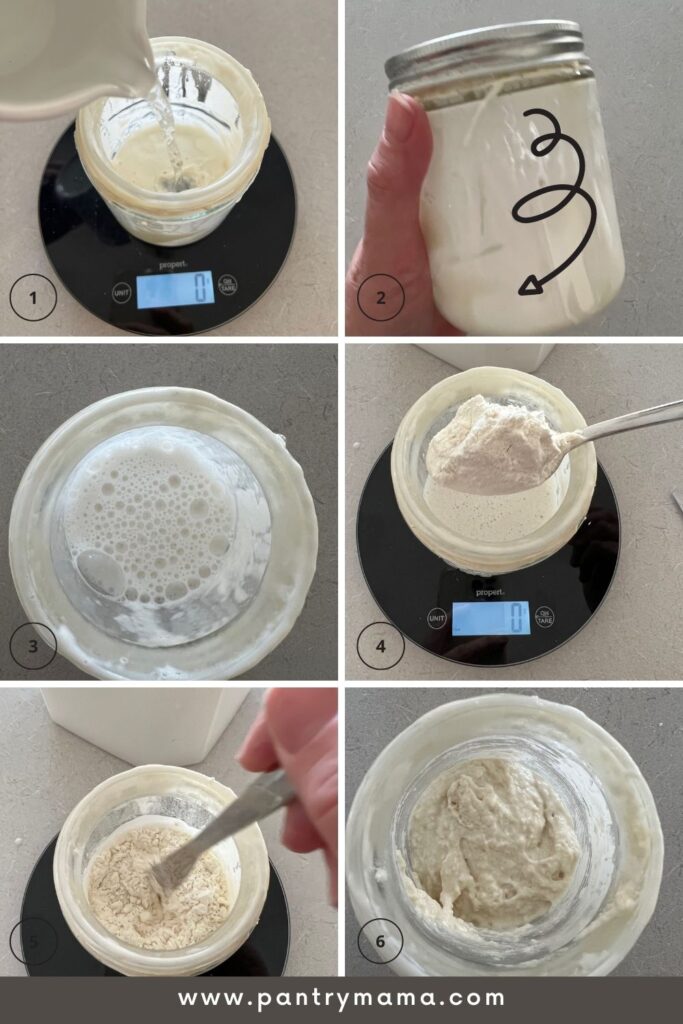
Measure Your Ingredients Carefully
Just like when you first created your sourdough starter, maintaining a sourdough starter still requires you to measure your ingredients carefully by weight - not volume.
Caring for your sourdough starter requires a digital kitchen scale for accuracy.
This is because half a cup of water and half a cup of flour do not weigh the same.
Measuring your sourdough starter ingredients by volume will starve your sourdough starter and make your baking efforts lacklustre.
Always measure your ingredients for sourdough baking using weight.
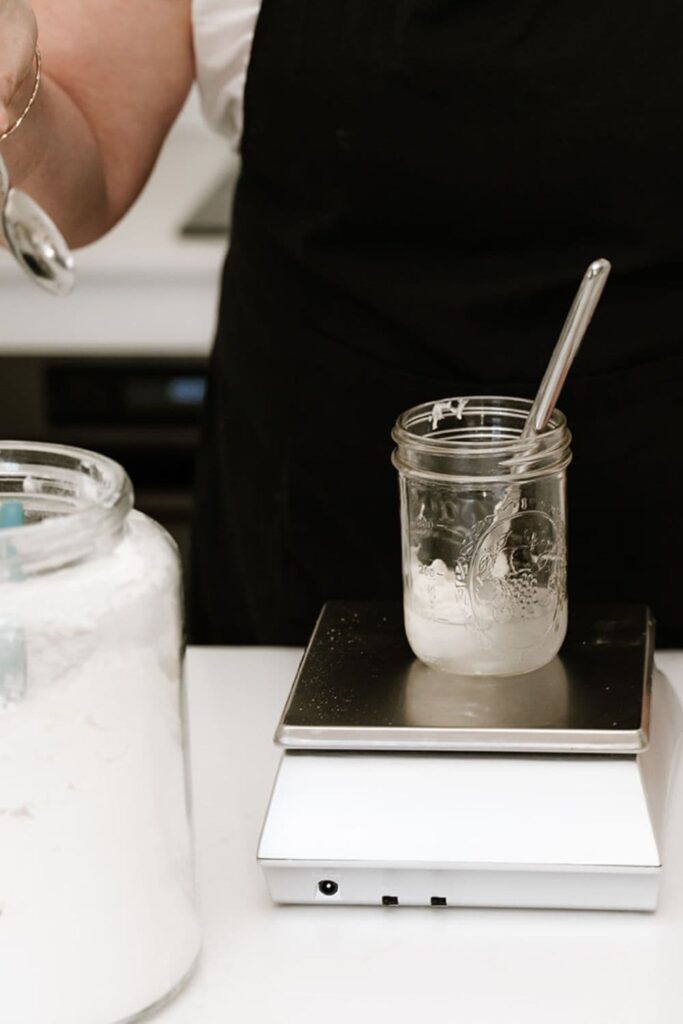
Do You Have To Discard Sourdough Starter Every Time You Feed It?
The short answer - yes! Sourdough starter must be discarded or reduced before each and every feeding. If you do not discard the starter it will grow exponentially and the acidity of the starter can also be affected.
Of course, once your starter is mature, the discarding of you starter looks a little different. The part you use for baking is then considered you "discard" and the remainder of the starter in the jar can then be fed.
Discard can be a confusing topic - but if doesn't have to be. I've written this guide to discarding your sourdough starter here. This goes through the how and why of sourdough discard in detail.
You'll also find 100+ sourdough discard recipes here - perfect for using any discard you have.
What Happens If You Forget To Feed Your Sourdough Starter?
If you forget to feed your sourdough starter, check it for mold. If there's no mold, discard and feed as normal. Depending on the time that has lapsed since its last feed, it may take a couple of feeds to come back to its regular health and behavior.
Sourdough starter is incredibly resiliant however as it is a living colony of micro organisms, it does need to be fed regularly while it is on the counter.
The fate of your sourdough starter really depends on its age and maturity. If you forget to feed your one month old sourdough starter for 3 days, you have a high risk of losing your starter to mold or bad bacteria.
If you forget to feed your six month old sourdough starter for 3 days, it will more than likely smell terrible but it won't necessarily die.
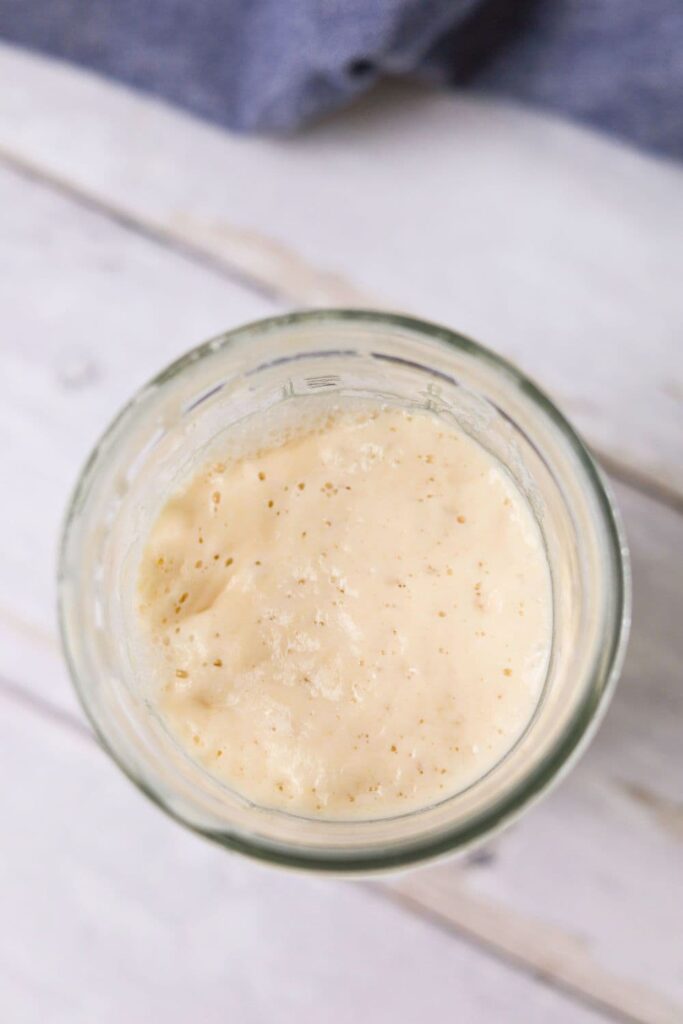
How Long Can A Sourdough Starter Sit At Room Temp?
As above, this is a question that depends on so many factors. It depends on what the room temperature actually is and how old and mature the sourdough starter is.
A sourdough starter will last longer at cooler temperatures than at warmer temperatures. At warmer temperatures (above 28C) the sourdough starter will become hungry and develop hooch very quickly.
At cooler temperatures (below 20C) the sourdough starter will take longer to rise and will maintain its peak for longer, prolonging hunger and preserving it.
A young sourdough starter (less than a month old) will not last long without feeding. It will develop mold or harmful pink bacteria rendering it "dead".
A more mature sourdough starter will be able to last at least a few days unfed on the counter.
If it is fed regularly, a sourdough starter will last indefinitely at room temperature, no matter what that temperature is.
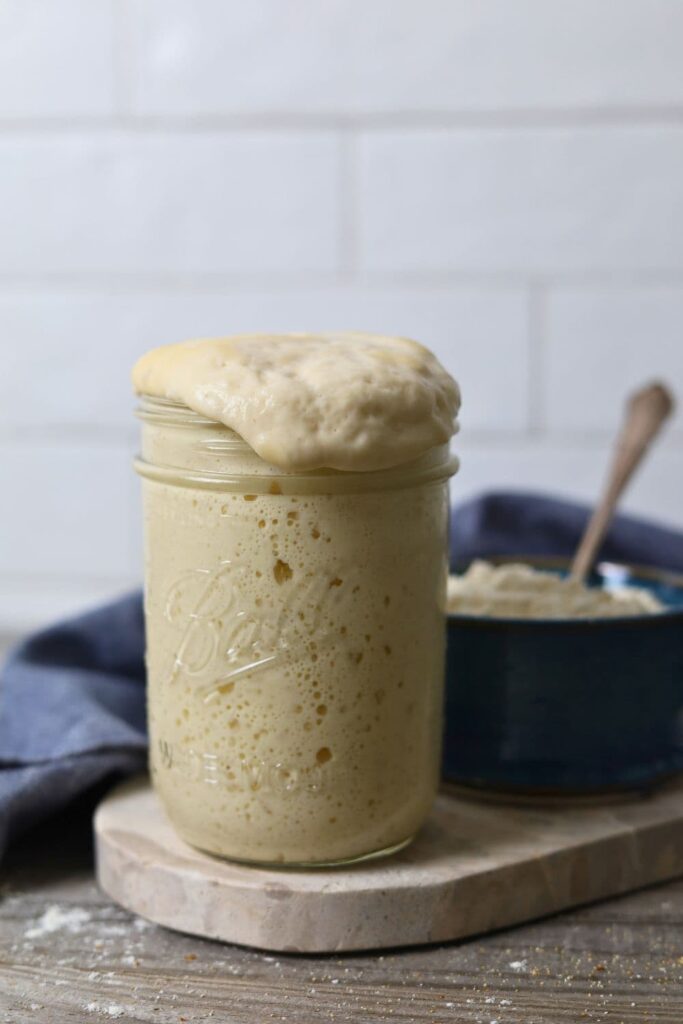
How To Tell If Your Starter Is Healthy
The health of your sourdough starter is imperative. The last thing you want to do is use a bad sourdough starter.
The most important thing to look for is mold. Basically, as long as there's no mold on your sourdough starter, it is considered alive and healthy.
Other things that you might notice or need to look out for are:
- Cloudy or dark liquid sitting on top of your starter (hooch)
- Kahm Yeast
- Watery or runny sourdough starter
- Smells like acetone or nail polish remover
As long as your sourdough starter shows no signs of mold, there's a pretty good chance you can bring it back to perfect health. One of the most frequently asked questions in my Facebook Group is "have I killed my sourdough starter?"
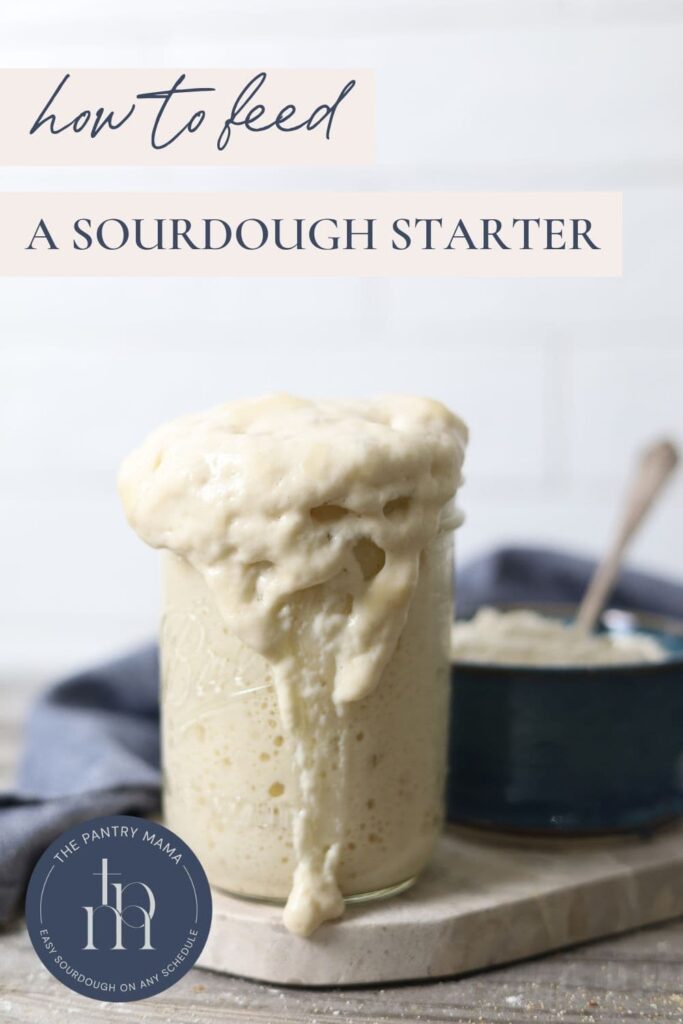
Frequently Asked Questions
When kept at room temperature, a sourdough starter should be fed every 12 to 24 hours to maintain a healthy and active wild yeast colony. Feeding less than this can put your sourdough starter at risk of developing mold or harmful bacteria.
Sourdough starter should be used at its peak. Using it before or after this point can affect the performance and flavor of your sourdough starter. The trick is to tune into your sourdough starter's own unique rhythm and understand when it peaks and when it falls.
When maintained at room temperature, a sourdough starter should not be sealed with an air tight lid. Just sitting the lid on the jar or screwing it part the way on is better. This allows the sourdough starter to "breathe" and be able to "off gas" as it rises and falls. If you screw the lid on tight and the jar is not big enough to accomodate the gases produced you risk the jar cracking or shattering with the pressure.
While your sourdough starter likes consistency, if you run out of the regular flour you feed it with, it will cope with a change if you can't get to the store. As long as it's the same type of flour (eg you could feed your all purpose starter with whole wheat flour because they're both wheat based flours). You wouldn't feed your all purpose starter with rice flour for example because rice flour has no gluten. For more information, you can read this guide to feeding your sourdough starter different flours.
You don't discard for the first 2 days when creating a sourdough starter from scratch, but if you are feeding an established starter then you can discard from the very first feeding by removing half of the starter from the jar.
Liquid on top of your sourdough starter is generally hooch, which is a by product of the fermentation process. You can read more about sourdough starter hooch here.

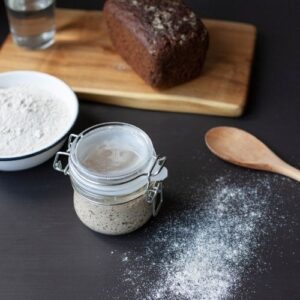
How To Maintain + Feed Sourdough Starter
Equipment
- Glass Jar with lid
- Digital Scale
Ingredients
- 50 g Sourdough Starter
- 50 g Flour bread, all purpose, whole wheat
- 50 g Water
Instructions
FOR KEEPING ON THE COUNTER
- Weigh out 50g of sourdough starter using a digital scale. Discard the rest of the starter (this can be used for discard recipes so long as your starter is at least 7 days old).
- To the 50g of sourdough starter, add 50g of flour and 50g of water. Stir the mixture vigorously.
- Leave the sourdough starter to rise in a warm place until at peak and ready to bake with.
FOR KEEPING IN THE FRIDGE
- Weigh out 25g of sourdough starter using a digital scale. Discard the rest of the starter (this can be used for discard recipes so long as your starter is at least 7 days old).
- To the 25g of sourdough starter, add 50g of flour and 50g of water. Stir the mixture vigorously. This is a 1:2:2 ratio to keep the starter happy in the fridge.
- For a full guide to storing sourdough starter in the fridge - go here.
Notes
- Use a digital scale to measure your ingredients (see the section below for more info)
- You don't always have to use a clean jar. Often your sourdough starter will thrive if left in its own jar. You can weigh your jar so you know what what it will weigh with 50g of sourdough starter in it. Then you can discard from the jar and feed into it.
- If feeding into a clean jar, always add water first, then sourdough starter then flour. This will enable you to mix it together more easily and you won't have such a mess.
- Once you've discarded, add water to your jar, screw on the lid and shake to mix the water and starter, then add the flour. Your starter will love this! Watch it grow!
Nutrition

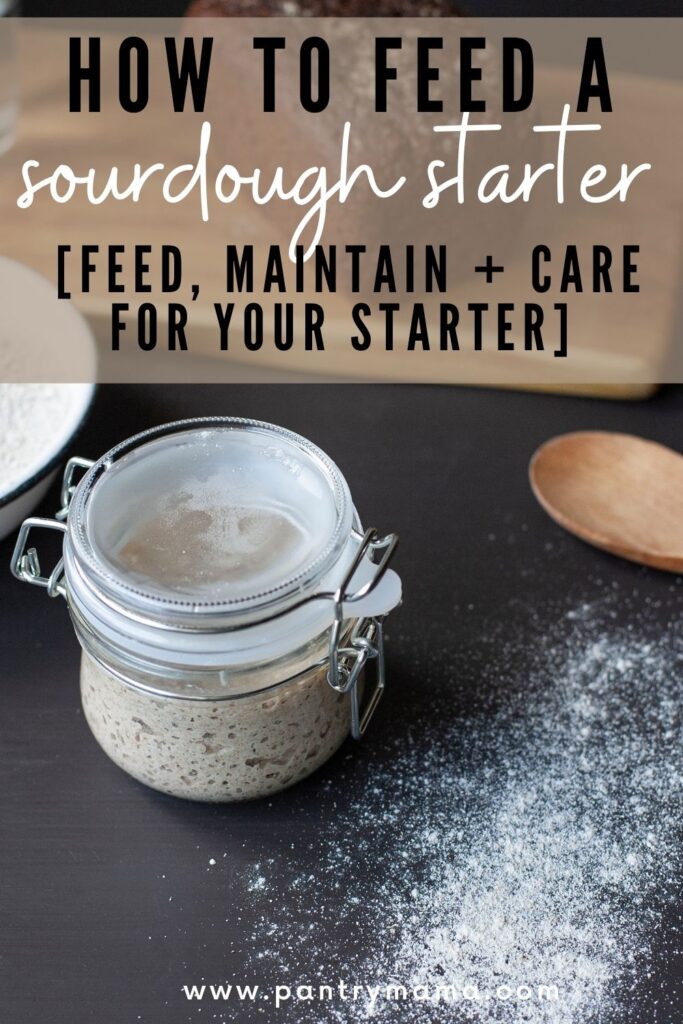

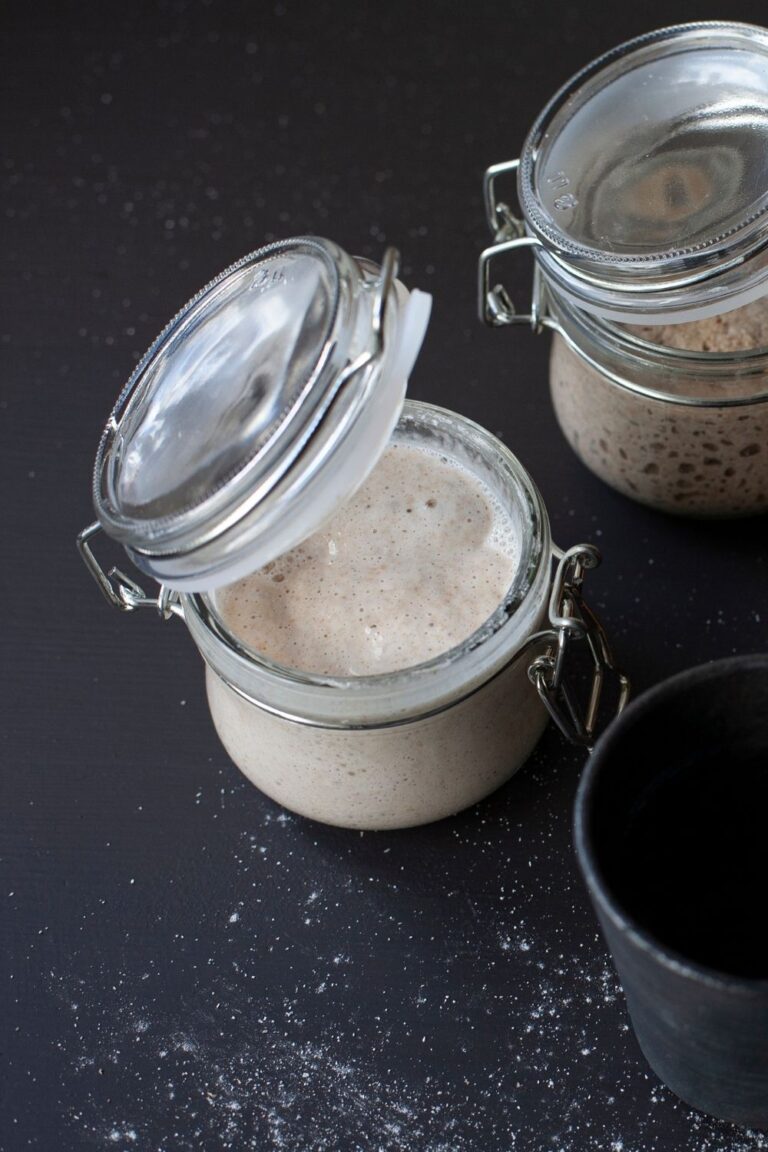
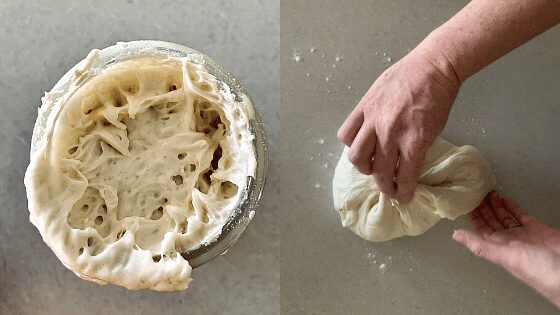
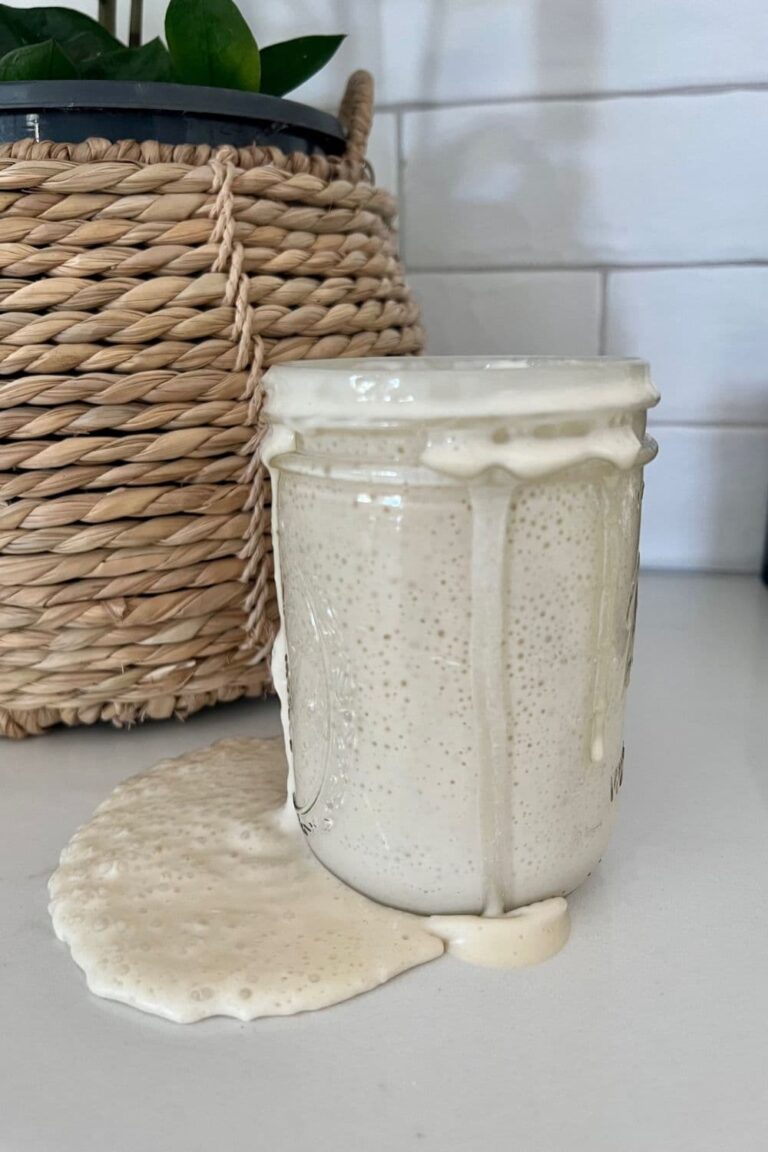
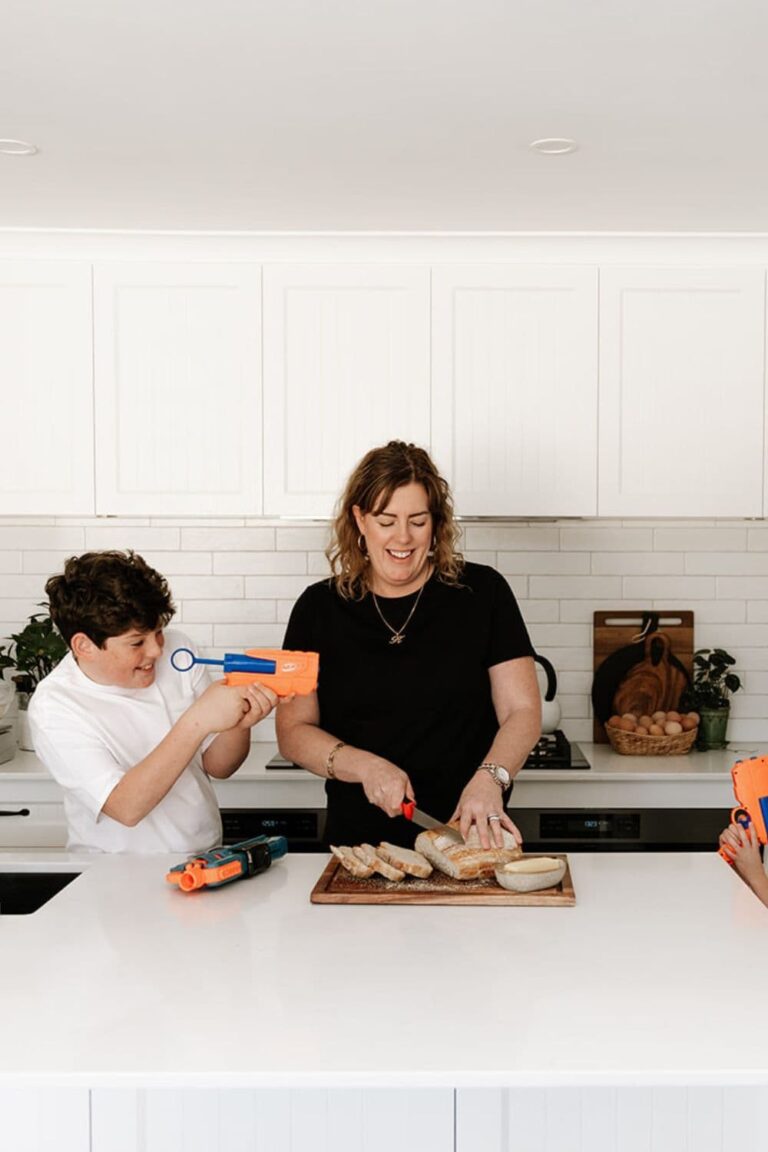

If you are feeding twice a day for a month and it doubles within 3-4 hrs it sounds like you can try once a day at that point. Is that correct? I really appreciate your recipes. I have had success with the recipes and creating the starter using your guidelines. Also had success with rising loafs of breads. I am wanting to try once a day feedings if possible? How much on ratios if you are doing once a day would you do 1 1 1 or 1 22? What kind of signs should I look for if I tried this in knowing is it working etc? I don’t want to mess it up this far in the process thanks!
Question, I use to feed 1:1:1 before putting it in the fridge but I did the 1:2:2 as suggested. I took it out today and it's thick. Usually it's like batter. Is this normal or did I mess up somewhere? Do I let it come to room temperature before I discard and feed to get ready to use it?
Hi,
If I want to have more than 150g total, can I have more than 50g left in jar after discard? As in, could I leave 100g starter in jar after discard, and add 100g flour and 100g water when I feed?
Thank you 😊
So, I just took my mature starter back out of the fridge after being in there for several months. It woke up after just 1 feeding. I've now been feeding it at a 1:1:1 ratio for the past 5 days. I think it's ready to bake with so I would like to make a loaf in the next few days. Should I change the feeding ratio in preparation for baking?
Does it matter how much starter I maintain? I've managed to keep a (gifted and very mature) starter alive on my counter for a couple of weeks now using a 1:2:2 every 12hrs or so. It usually triples by 12hrs. But I am only maintaining 10g of starter in a small jelly jar. I've only baked bread with it 3 times (I've also done a few discard recipes). The first loaf seemed pretty good but I had zero knowledge and just followed the recipe the gifter gave me which had a REALLY bazaar ratio. My second loaf was severely under proofed because I let it batch ferment in a very cold garage for 24 hours. The third loaf was a sandwich bread that seemed ok enough (but I didn't really know what it was supposed to look like). Now that I've read through most of your entire site and several others on SD I have consistently seen starter maintained at 50g and I'm wondering why. Will it affect the end result? I'm kind of cheap and I am not consistent with my baking schedule just yet and would like to continue to maintain a really small starter, but not at the expense of it not being successful. I appreciate this blog. Your articles are very helpful and easy to follow. Thank you for all of this effort.
My SIL gave me starter yesterday, she fed it before she gave it to me and then i put it in the fridge that night because I was a bit lost at what to do. If i want to cook with it, what do i do next? Can i take it out even though i just put it in there last night? Do i need to feed it today when i take it out of the fridge?
If it's only been in the fridge a few days, you'll likely just need to place it on the counter and let it warm up a bit before baking with it. You may need more steps though if it's been refrigerated for awhile. This guide on storing sourdough starter in the fridge has a ton of circumstances and recommendations.
So helpful, thank you! I purchased a Yukon sourdough starter kit and it said nothing about discarding some of the starter every time you feed it. So I just kept adding flour and water to it every day for about ten days without discarding anything. I was wondering why it wasnt bubbling and reacting so I did research on my own and started feeding it at a 1:1:1 ration instead. It seems to be building up and bubbling just fine now. I plan to start using it once it starts doubling after a feed. But is it still safe to use even though it sat as a soupy texture for a week and a half? My concern is food poisoning...
As long as you discarded it and then changed to the 1:1:1 and are now discarding before every feed it should be fine. Keep an eye out for mold and ensure it smells pleasant and yeasty and it will be ok 🙂
Thanks so much for this excellent site on starters, pantrymama…easy to read and understand without complication !!👍